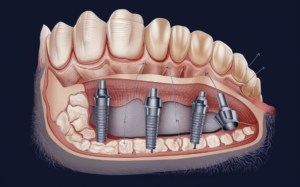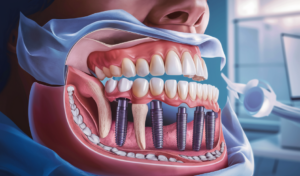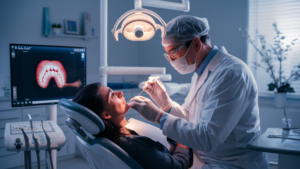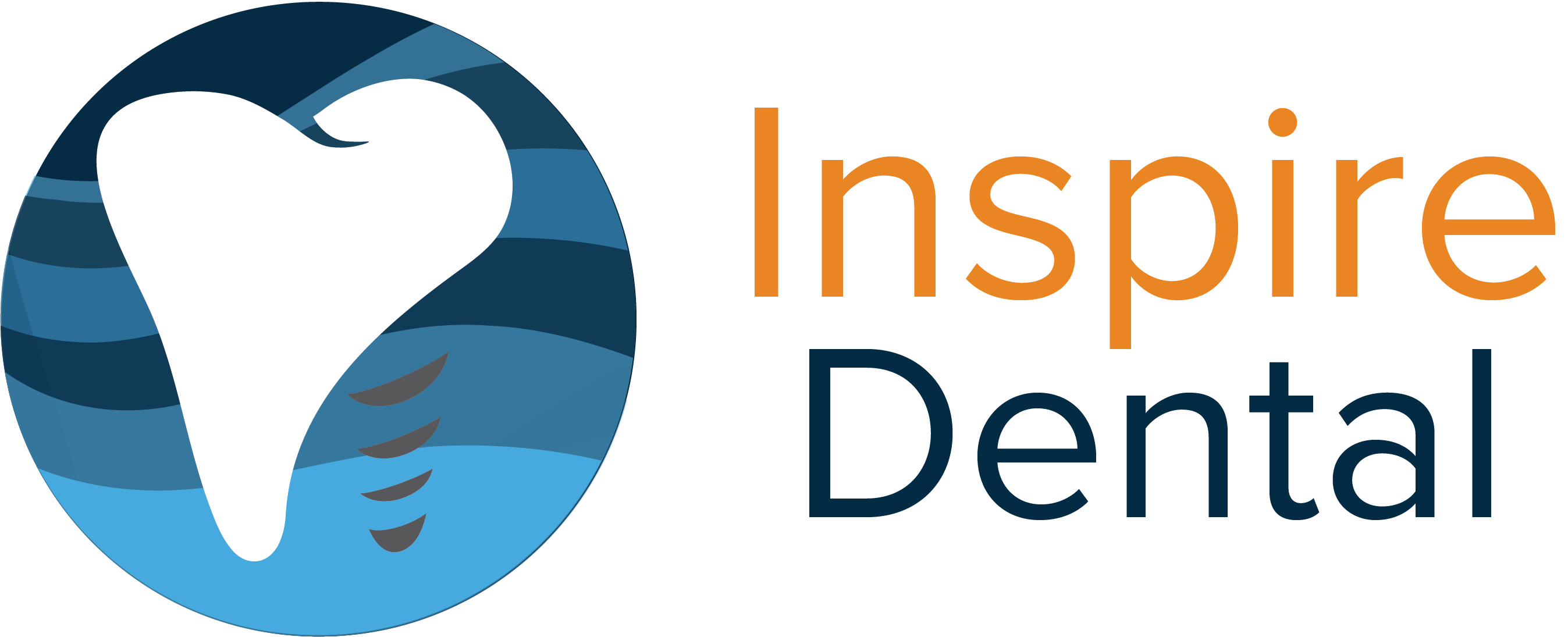Bone grafting for implants is a vital procedure that helps patients with insufficient jaw bone density achieve successful dental implant placement. This surgical technique involves adding bone material to the jaw to create a solid foundation for implants. For residents of Ottumwa, Iowa seeking dental implant solutions, understanding bone grafting is crucial for making informed decisions about their oral health.
Key Takeaways:
- Bone grafting increases jaw bone density to support dental implants
- The procedure is often necessary for patients with bone loss due to tooth extraction or gum disease
- Several types of bone graft materials are available, including synthetic options
- Recovery time varies but typically takes 3-6 months before implant placement
- Bone grafting has a high success rate when performed by experienced dentists
- Patients in Ottumwa can benefit from local expertise in bone grafting and implant procedures
Understanding Bone Grafting for Implants

Bone Grafting for Implants is a surgical procedure that adds bone or bone-like materials to the jaw. Its main purpose is to create a strong foundation for dental implants. When a tooth is lost, the surrounding bone can deteriorate over time. This bone loss can make it difficult or impossible to place dental implants without first rebuilding the bone structure.
For patients in Ottumwa considering dental implants, a bone graft might be necessary if their jawbone has thinned or receded. This is common in cases where teeth have been missing for a while or where gum disease has caused bone loss. The goal of bone grafting is to stimulate new bone growth, providing a solid base for the implant to integrate with the jaw.
Types of Bone Grafting for Implants Used in Dentistry

There are several types of bone grafts that dentists in Ottumwa might use, depending on the patient’s specific needs:
Autografts
Autografts use bone taken from another part of the patient’s body, often from the hip or the back of the jaw. This type of graft is considered the gold standard because it uses the patient’s living bone cells, which can lead to faster healing and integration.
Allografts
Allografts use human bone from a donor, which is carefully screened and processed to ensure safety. This option is good for patients who prefer not to have bone removed from another part of their body.
Xenografts
Xenografts use bone from an animal source, typically a cow. These grafts are processed to remove any organic material, leaving only the mineral structure of the bone.
Synthetic Grafts
Synthetic grafts, also called alloplasts, are made from biocompatible materials that mimic the structure of natural bone. These can be a good option for patients who prefer not to use animal or human donor tissue.
The Bone Grafting Procedure

The bone grafting procedure is typically performed in a dental office under local anesthesia. For patients in Ottumwa who are anxious about dental procedures, sedation options may be available to ensure comfort throughout the process.
Preparation
Before the procedure, the dentist will thoroughly examine the patient’s mouth and take X-rays or 3D scans to assess the extent of bone loss and plan the graft precisely.
The Surgery
During the surgery, the dentist will make an incision in the gum to expose the bone. The graft material is then carefully placed in the area where more bone is needed. In some cases, a membrane may be placed over the graft to protect it and guide bone regeneration.
Closing the Site
After the graft is in place, the dentist will close the incision with stitches. The healing process then begins, during which new bone will grow and integrate with the graft material.
Recovery and Healing
Recovery from bone grafting varies from patient to patient, but most people in Ottumwa can return to their normal activities within a few days. However, complete healing of the bone graft typically takes several months.
Immediate Post-Op Care
Patients will need to follow specific instructions for care in the days following surgery, including:
- Applying ice to reduce swelling
- Taking prescribed pain medications and antibiotics
- Avoiding strenuous activity for a few days
- Eating soft foods and avoiding the surgical site when chewing
Long-Term Healing
Over the next few months, the bone graft will integrate with the existing bone. This process, called osseointegration, is crucial for creating a strong foundation for dental implants.
Bone Grafting Success Rates
Bone grafting for dental implants has a high success rate, especially when performed by experienced dentists. In Ottumwa, patients can find skilled professionals who regularly perform this procedure with excellent outcomes.
| Factor | Impact on Success Rate |
|---|---|
| Patient’s overall health | High |
| Smoking status | Significant negative impact |
| Adherence to post-op instructions | Moderate to high |
| Quality of bone graft material | High |
| Dentist’s experience | Very high |
Preparing for Bone Grafting
If you’re considering bone grafting for dental implants in Ottumwa, there are several steps you can take to prepare:
- Schedule a consultation with a local dentist experienced in bone grafting
- Discuss your medical history and any medications you’re taking
- Ask about the type of bone graft material that will be used
- Inquire about the expected timeline for healing and implant placement
- Discuss payment options and insurance coverage
Alternative Options to Consider
While bone grafting is often the best choice for creating a strong foundation for dental implants, there are some alternatives that Ottumwa patients might consider:
Short Implants
In some cases, shorter dental implants can be used in areas with less bone density, potentially avoiding the need for a bone graft.
Zygomatic Implants
For severe upper jaw bone loss, zygomatic implants that anchor in the cheekbone may be an option, though these are less common.
All-on-4 Technique
This technique uses angled implants to maximize the use of available bone, sometimes eliminating the need for bone grafting in full-arch restorations.
Cost Considerations for Bone Grafting for Implants
The cost of bone grafting can vary widely depending on the extent of the procedure and the type of graft material used. In Ottumwa, patients should expect costs to range from several hundred to a few thousand dollars per graft site.
| Procedure Component | Estimated Cost Range |
|---|---|
| Simple bone graft | $300 – $800 |
| Complex bone graft | $1,500 – $3,000 |
| Sinus lift procedure | $1,500 – $4,000 |
It’s important to note that these are estimates, and actual costs may vary. Many dental offices in Ottumwa offer financing options to help make bone grafting and implant procedures more affordable.
Choosing the Right Dentist for Bone Grafting

Selecting the right dentist for your bone grafting procedure is crucial for achieving the best possible outcome. Look for a dentist who:
- Has specific training and experience in bone grafting techniques
- Uses advanced imaging technology for precise planning
- Offers a comprehensive consultation to discuss your options
- Has positive reviews and testimonials from previous patients
- Provides clear information about the procedure, recovery, and costs
The Future of Bone Grafting in Dentistry
As dental technology continues to advance, bone grafting techniques are becoming more refined and effective. Ottumwa residents can look forward to:
- Improved graft materials that promote faster bone growth
- Minimally invasive techniques that reduce recovery time
- 3D-printed custom bone grafts tailored to each patient’s anatomy
- Growth factor therapies to enhance bone regeneration
These advancements promise to make bone grafting for implants even more successful and accessible for patients in Ottumwa and beyond.
Conclusion
Bone grafting for implants is a valuable procedure that can help many Ottumwa residents achieve their goal of a complete, healthy smile. By understanding the process, preparing properly, and choosing the right dental professional, patients can approach bone grafting with confidence.
Whether you’re dealing with bone loss from missing teeth or seeking to improve your candidacy for dental implants, bone grafting offers a reliable solution to rebuild your jaw and support long-lasting dental restorations. For more information, you can visit our website or contact us.
